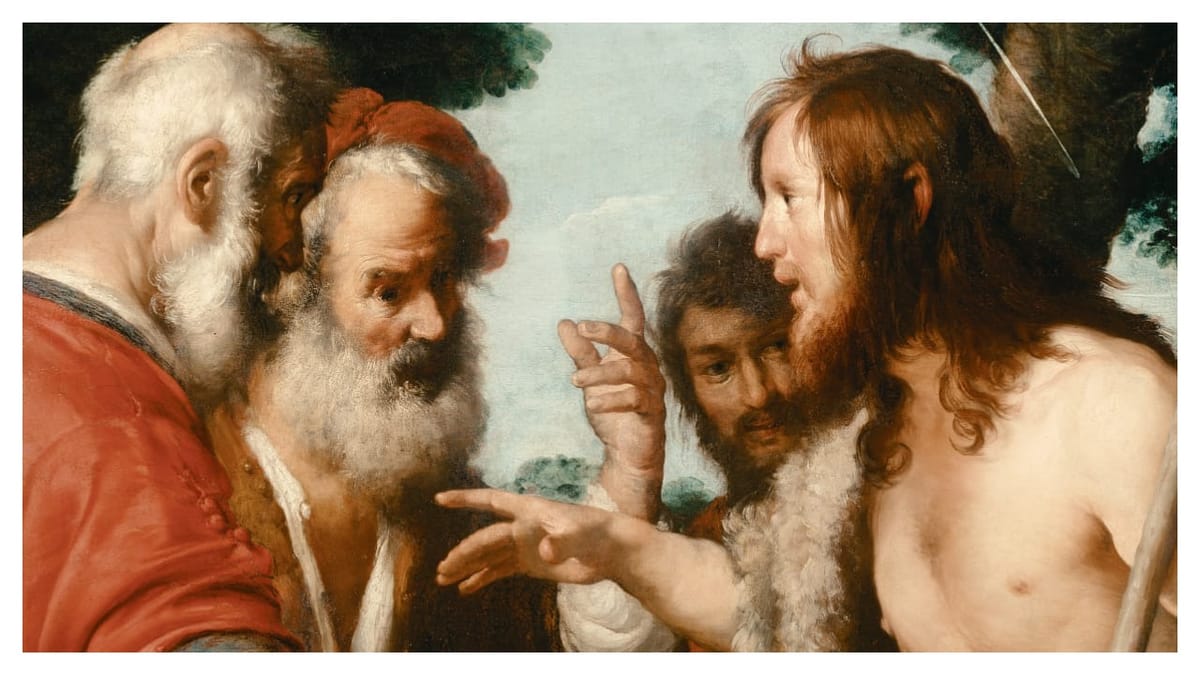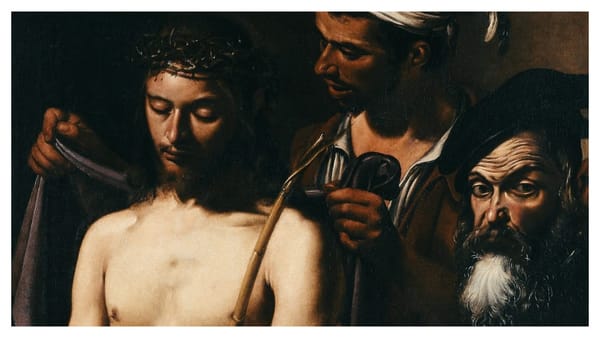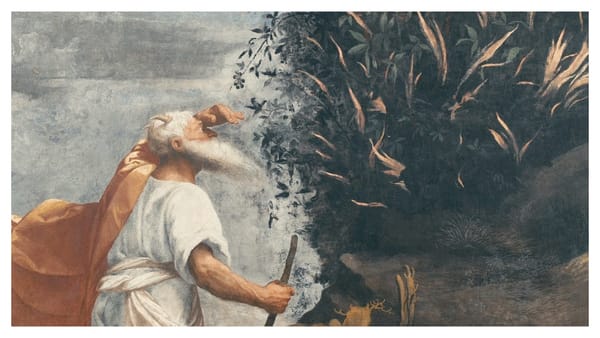The Priestly Garments—From Genesis to Revelation
From Eden's lost covering to Revelation's throne: a masterful exploration of how priestly consecration leads to kingly authority in God's redemptive plan.

The Bookends of Human History
In the book of Revelation, Christ's message to the Laodicean church carries a striking urgency: "I counsel thee to buy of me gold tried in the fire, that thou mayest be rich; and white raiment, that thou mayest be clothed, and that the shame of thy nakedness do not appear; and anoint thine eyes with eyesalve, that thou mayest see" (Rev. 3:18). This three-fold counsel—gold, garments, and eye-salve—speaks directly to our present spiritual condition. We stand in need of tested faith, spiritual covering that brings both salvation and authority, and true prophetic vision.
To fully grasp the weight of this counsel and chart our path forward, we must return to where this story of spiritual covering began. In the garden of Eden, we find the first instance of humanity's need for divine covering—a pattern that would echo throughout scripture until finding its ultimate fulfillment in the last church age.
The symmetry between these bookends of human history is profound. In Genesis, we encounter one man and one woman in need of covering after their fall. By the time we reach Revelation, we see this same need magnified across an entire people. Yet in both cases, the fundamental issues remain the same: nakedness, shame, and the divine provision of covering. This is no mere coincidence—it reveals God's consistent dealing with humanity regarding covering and authority.
What makes this connection even more significant is how it traces the development of sonship throughout scripture. In Genesis, we see Adam, a created son, requiring covering. In Revelation, we find the description of the Resurrected Christ, clothed in a garment down to His feet (Rev. 1:13), representing the perfect Son. Between these points, we see God's progressive work to bring forth mature sons. What began with one man has expanded to include a corporate body of believers being conformed to the image of the Son.
This divine narrative moves from seed to full manifestation. What was planted in Genesis—the need for and provision of divine covering—grows into a mighty tree in Revelation, where an entire company of Overcomers stands clothed in white raiment. The pattern established in the garden finds its complete fulfillment in the final church age, where the stakes are not merely individual but corporate in scope.
Our present position in this narrative—the Laodicean church age—demands our attention. We stand at the culmination of this divine pattern, where the requirements for covering and authority reach their highest expression. The individual covering provided for Adam and Eve now expands to encompass a corporate body being prepared for the manifestation of mature sonship.
"In Eden, divine covering was needed for two; in Revelation, it awaits a prepared people. The counsel echoes through time: refined gold for faith, white raiment for covering, eye-salve for vision. Our generation stands at this confluence of beginning and end, called to complete the narrative of sonship from Garden to Glory."
The First Sacrifice and Priesthood
Having established humanity's need for covering, we encounter a profound moment in Genesis 3:21 where God reveals Himself in a new role. Here, we see the first manifestation of God not merely as Creator, but as Priest. This transition is crucial for understanding both our present need and God's prescribed solution.
After the transgression, we find Adam—still a son of God by creation—cut off from fellowship with his Father. While his relationship remained (for nothing could alter his status as a created son), his fellowship was severed, evidenced by his inability to partake of the Tree of Life. Death now worked in his body, and he stood in desperate need of covering. This scene sets the stage for God's revelation of the path back to fellowship.
The Hebrew word for "offering," korbanot, literally means "to draw near." This etymology reveals the heart of God's sacrificial system—it was never about mere ritual, but about restoration of fellowship. Yet this drawing near could not happen arbitrarily. God established specific requirements and a precise order. From the beginning, we see that mankind can only approach God on His terms, never our own.
In this first sacrifice, God establishes the pattern of the olah offering—the whole burnt offering. This was unique among all the Levitical offerings in that the entire animal was consumed on the altar, save for one portion: the skin, which was reserved for the priest. The fact that God slew an animal and retained its skin provides crucial insight into the nature of this first sacrifice. This wasn't just any offering—it was specifically a whole burnt offering, with God Himself functioning as Priest.
What follows is deeply significant: with the same intentionality that He "made" (asa) the worlds, God now "made" coats for His children. The choice of the same Hebrew word suggests similar care and craftsmanship. Given the size necessary to cover both Adam and Eve, it was likely a bull—the most costly of the burnt offerings—that provided the skin for these garments.
This ancient scene illuminates Christ's counsel to Laodicea: there can be no covering without sacrifice, and not just any sacrifice will suffice. The whole burnt offering represents complete dedication—God doesn't desire merely a portion of our lives, but rather total consecration. This truth is embedded in the very name of the offering itself: olah means "to ascend." It reveals the profound reality that complete surrender is the only path to elevated fellowship with God.
The parallels to our present condition are striking. Just as Adam needed covering after his fall, and just as this covering could only come through a specific type of sacrifice administered by God Himself acting as Priest, so too does the Laodicean church require covering that can only come through complete consecration. The pattern established in that first sacrifice remains our pattern today—God still requires the whole burnt offering of our lives to provide the covering we need.
"At humanity's fall, God initiated priesthood through sacrifice, establishing an eternal pattern: complete surrender precedes divine covering. Today's church stands before the same altar, discovering that fellowship restored demands nothing less than total consecration."
The Pattern Fulfilled
The pattern established in Eden finds its perfect fulfillment in Christ, who uniquely embodied both Priest and Sacrifice. Just as the original burnt offering was wholly consumed, leaving only the skin for covering, Christ offered Himself completely on our behalf. This offering wasn't partial—it represented the ultimate whole burnt offering, a sacrifice of total consecration that fulfilled and transcended the Levitical pattern.
What makes this fulfillment particularly profound is its dual nature. As High Priest, Christ offered the sacrifice. As the Sacrifice itself, He was completely consumed by the fire of God's judgment and holy requirements. Yet from this complete consumption comes our covering. When Paul instructs us to "put on Christ" (Romans 13:14) or declares that we have "clothed ourselves with Christ" (Galatians 3:27), he's drawing directly from this pattern of sacrifice and covering established in Eden.
The implications are staggering. The skin of the first sacrifice could cover only the physical nakedness of two people. But the covering provided through Christ's sacrifice—His very Life—becomes the spiritual covering for an entire company of believers. When we "put on Christ," we're not merely receiving a covering—we're participating in the very life that was offered as a whole burnt offering. His Life becomes our covering, His consecration our pattern, His priesthood our calling.
This fulfillment of the ancient pattern illuminates our path forward. Just as Christ functioned as both Priest and Sacrifice, we too are called to this dual role—to be priests who offer ourselves as living sacrifices. The garments of salvation available to us come through the same pattern: complete consecration leading to divine covering. The corporate Body, particularly in this Laodicean age, must follow the pattern seen in Eden, fulfilled in Christ, and now outworked in us. We must become priests.
"In Christ—perfect Priest and ultimate Offering—Eden's first covering finds its fulfillment and expansion. To put on Christ is to wear more than a garment; it is to be clothed in His very life. His consecration becomes our pattern, His priesthood our inheritance, calling forth a corporate Body into His complete surrender."
The Present Call to Priesthood
The priestly calling laid upon the church today isn't merely metaphorical—it's a divine mandate requiring specific preparation and particular covering. Just as the priests of old couldn't minister without their prescribed garments, our priestly service demands appropriate spiritual covering. This progression of priestly garments in Scripture is telling: from the mixed materials of wool and linen (representing the interplay of natural and spiritual) to pure linen garments that "cause not to sweat"—a prophetic picture of moving beyond human effort into divine rest. These weren't mere suggestions but requirements for service, and their spiritual reality remains just as crucial today.
How then do we acquire these spiritual garments? The path remains unchanged: consecration, spiritual preparation, and absolute obedience. It requires a decisive "putting off" of the old nature and a deliberate "clothing" with Christ Himself. This exchange of garments isn't a one-time event but a daily reality of priestly service.
Paul captures this paradoxical existence in his declaration: "I am crucified with Christ: nevertheless I live; yet not I, but Christ liveth in me" (Galatians 2:20). This is the essence of being a "living sacrifice" as described in Romans 12:1. When Jesus promised His disciples would receive power to "be witnesses" (Acts 1:8), He used the Greek word "martus"—from which we get our word martyr. This wasn't just about testimony through words but through complete life surrender. Like the olah offering, nothing is held back; we're called to be wholly consumed, yet perpetually alive in Christ.
The purpose of these offerings—korbanot in Hebrew—was always about drawing near, about restored fellowship with God. The ultimate goal is the restoration of that original shekinah glory that clothed Adam before the fall. This transformation process involves two manifestations of divine fire: the testing fires of trials that purify our faith, and the glory fires that transform us from glory to glory into His image. These dual operations of fire—both in suffering and blessing—are God's tools for forming His overcoming priesthood.
Here we stand in the Laodicean age, in many ways as desperately needy as Adam after the transgression. Yet we stand with a better sacrifice and a more excellent covenant. Everything required for full restoration of fellowship with God has been provided through Christ. However, this provision demands our response—decisive action and entire consecration. Just as the burnt offerings were made daily in the temple, we're called to daily sacrifice—not of animals, but of our wills, our desires, our entire beings in complete submission to our Heavenly Father.
This daily surrender to divine purpose isn't optional for those seeking to function in true priestly ministry. It's the very means by which God's perfect will becomes manifest in our lives. We must fully submit ourselves to His dealings, yielding completely to His purposes. The garments of authority and covering we seek in this Laodicean hour can only be received through this path of total consecration.
This universal call to priesthood—evident from God's declaration at Sinai of "a kingdom of priests" (Exodus 19:6) to its echo in Revelation where we're "made kings and priests unto God" (Revelation 1:6, 5:10)—shows that this was always God's intent for His people. The final church age isn't about surviving until Christ's return; it's about becoming that fully functioning priesthood that can stand in His presence, properly clothed in His glory, mediating His life to a dying world.
Yet this path of priestly consecration, as demanding as it is, points toward an even greater reality. The daily sacrifices and submissions that mark authentic priestly ministry are actually preparing us for a higher calling—one that transforms priests into kings.
"The priestly calling of this final age demands garments forged in consecration, maintained through obedience. As the ancient priests could not serve unclothed, we cannot minister without Christ as our covering—not mere external attire, but His life becoming our garment."
The Path to Glory: From Priests to Kings
What began in Genesis as a story of lost covering culminates in Revelation with a profound promise of restored authority. The path to this restoration follows a divine progression that hasn't changed since it was first established: "This is the thing which the LORD commanded that ye should do: and the glory of the LORD shall appear unto you" (Leviticus 9:6). This ancient promise holds the key to our present transformation.
The journey begins with complete surrender. Just as the olah offering was wholly consumed on the altar, we present our bodies as living sacrifices (Romans 12:1). This isn't a partial offering—it demands everything, mirroring Christ's own complete submission to the Father's will. Our obedience, as described in Hebrews 10:6-9, must be as absolute as His: "Lo, I come to do thy will, O God." This voluntary submission positions us to function in our priestly calling, fulfilling God's original declaration of "a kingdom of priests" (Exodus 19:6).
But priesthood isn't the final destination—it's the pathway to something greater. As we faithfully execute our priestly ministry through daily sacrifice and consecration, His glory begins to appear. This glory isn't merely a spiritual experience; it's the restoration of the original covering Adam knew before the fall. It's what Moses glimpsed on the mountain, what the priesthood encountered in the Holy of Holies, what the disciples witnessed at the Transfiguration, and what awaits the prepared end-time church.
Here lies the profound truth revealed in Christ's promise to the overcomers: "To him that overcometh will I grant to sit with me in my throne, even as I also overcame, and am set down with my Father in his throne" (Revelation 3:21). The progression is remarkable—from naked and fallen in Genesis, to covered through sacrifice, to functioning as priests, and finally to seated as kings with Christ in His throne. What Adam lost in the Garden—his authority as God's representative ruler—is fully restored in the overcoming church, now clothed with Christ Himself and seated with Him in heavenly places.
This is the ultimate purpose of the garments we seek in this Laodicean hour. They aren't merely for covering shame or even for priestly service—they are royal robes of authority. Through the path of priestly ministry and complete consecration, we graduate to kingly authority. The same church warned about its nakedness is promised a throne, showing the transformative power of divine covering properly sought and received.
The mantles of authority revealed in prophetic vision aren't just waiting to be claimed—they're waiting for a prepared, consecrated people who have followed this divine path. A priesthood that has learned to offer everything in living sacrifice. A people who have submitted to both the testing fires of trials and the transforming fires of glory. A company of believers who have allowed Christ's life to so fully become their covering that they qualify for the ultimate promise: shared throne authority with the King of Kings.
This is our destiny in this final hour—not just to recover what Adam lost, but to fulfill what God intended from the beginning: a company of priest-kings, fully clothed in Christ, exercising His authority in the earth. The path has been set before us. The price has been revealed. The throne awaits those who will overcome.
"Priesthood marks the path, but kingship reveals the destination. Through complete yielding, we gain not just covering but crown authority. The overcomer's promise extends beyond mere position—it restores Eden's lost dominion, clothing us in garments of divine sovereignty."
Closing Reflection
From Genesis to Revelation, we trace a single thread: the story of divine covering and restored authority. What began with God clothing two fallen children in Eden culminates in His clothing of a corporate Body with royal garments of authority. This journey from nakedness to glory, from shame to throne, stands as both invitation and challenge to the final church age.
The Laodicean counsel echoes with renewed urgency in our generation: buy refined gold, seek white raiment, anoint your eyes. Yet we now understand these aren't merely individual imperatives—they are corporate stepping stones toward our ultimate destiny. The gold speaks of faith tested in dual fires: the crucible of trials and the furnace of His glory. The garments represent not just covering, but the very life of Christ becoming our identity. The eye-salve grants vision to see beyond present circumstances to eternal purpose.
Every step of priesthood—daily sacrifice, complete consecration, absolute surrender—prepares us for this greater weight of glory. We don't merely serve in the outer court; we're being prepared for throne room authority. The progression is profound: what was lost in a garden is more than restored in a throne room. The covering first provided through sacrifice becomes the royal garment of divine authority.
As we stand in this pivotal hour, may we embrace both the privilege and responsibility of our calling. Let every act of priestly service, every moment of surrender, every instance of obedience become another thread in the garment of glory being woven for an overcoming people. For in the end, this isn't merely about personal transformation—it's about the manifestation of mature sons, clothed in Christ, exercising His authority in the earth.
"From Eden's covering to Revelation's crown, the path is clear: through sacrifice to glory, through priesthood to kingship. The garments await, the throne beckons, as Heaven prepares a people who will wear both the priest's linen and the king's purple—fully clothed in Christ, fully seated in authority."




